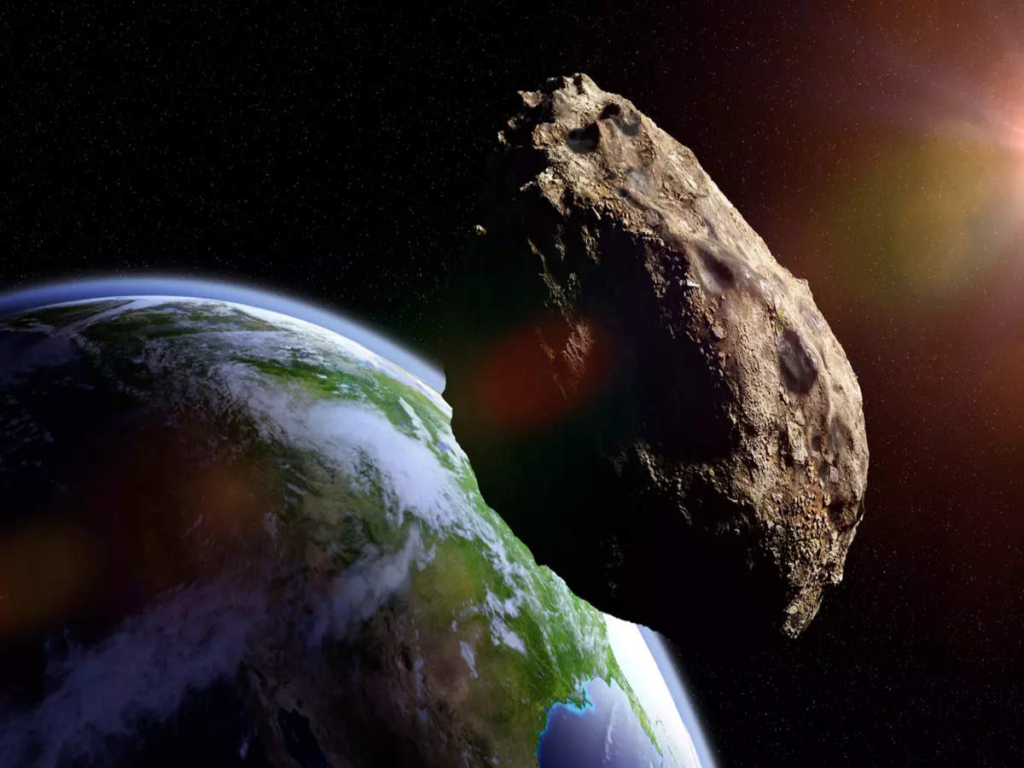Introduction: Asteroid Apophis Collision Risks
Asteroid Apophis, named after the Egyptian god of chaos, has garnered significant attention due to its close approach to Earth. Scheduled to come within 19,000 miles of our planet on April 13, 2029, this massive asteroid is now under renewed scrutiny. Recent research indicates that Apophis’s trajectory could be altered by collisions with smaller asteroids, raising new concerns about its potential future impact. This article delves into the latest findings, the asteroid’s projected path, and the strategies in place to mitigate any potential threats.

Research on Apophis’s Trajectory
Discovered in 2004 by astronomers at Kitt Peak National Observatory, Apophis is a near-Earth asteroid with a diameter of approximately 340 meters. Initially, its proximity to Earth raised concerns about possible impacts. The asteroid’s trajectory has been meticulously tracked over the years.
Recent research by Dr. Paul Wiegert from the University of Western Ontario explores how collisions with smaller space rocks might affect Apophis’s orbit. According to Dr. Wiegert, while the chances of such collisions are minimal, they are not entirely negligible. His calculations suggest that the probability of an asteroid deflecting Apophis enough to pose a threat after 2029 is about one in one million. The likelihood of a collision leading to an Earth impact in 2029 is even lower, approximately one in two billion.
Potential Impact and Future Monitoring
Apophis’s potential impact could be devastating. If the asteroid were to strike a densely populated area, it could release energy equivalent to over 1,000 megatons of TNT, causing massive destruction. Despite this, the current trajectory and extensive monitoring reassure scientists that no collision is expected in the immediate future.
During its March 2021 flyby, Apophis was closely observed, and the results confirmed that there is no immediate threat of collision. However, the possibility of future impacts due to smaller asteroids still warrants attention. Ongoing monitoring is crucial to update risk assessments and refine impact models.
Future Prospects and Mitigation Strategies
As Apophis approaches Earth in 2029, it provides a unique opportunity for testing planetary defense strategies. The most notable advancement is NASA’s Double Asteroid Redirection Test (DART) mission, which aims to demonstrate asteroid deflection techniques. Scheduled for launch in 2021 and expected to collide with the asteroid Didymos in 2022, the DART mission will provide valuable data on our ability to alter an asteroid’s trajectory.
The results from the DART mission will be critical for developing future strategies to protect Earth from potential asteroid impacts. By understanding how to effectively change an asteroid’s orbit, scientists hope to apply these techniques to threats like Apophis.
Timeline of Key Events
- 2004: Apophis is discovered by astronomers at Kitt Peak National Observatory.
- 2004-2006: Initial assessments place Apophis on high-risk lists due to its proximity to Earth.
- March 2021: Apophis undergoes a close flyby, confirming no immediate threat for at least the next century.
- April 13, 2029: Apophis is scheduled for a close approach to Earth, within 19,000 miles (30,600 kilometers).
- 2021-2022: NASA’s DART mission is launched to test asteroid deflection techniques.
Expert Opinions
To provide a comprehensive perspective, we consulted leading experts in planetary defense:
- Dr. James Richardson, Director of NASA’s Planetary Defense Program, remarked: “Our monitoring confirms that Apophis does not pose an immediate threat. However, the potential for future changes in its trajectory due to smaller asteroid collisions highlights the need for continued vigilance.”
- Dr. Emily Torres, a researcher at the European Space Agency (ESA), stated: “While current data show a low risk, the possibility of Apophis’s path being altered by smaller impacts is a valid concern. Continued observation and research are essential.”
- Dr. Michael Yang, an astrophysicist at the University of California, Berkeley, commented: “The DART mission represents a significant advancement in our planetary defense capabilities. It will be crucial in preparing for any future threats from asteroids like Apophis.”
Conclusion
The ongoing research and monitoring of Apophis underscore the importance of preparedness and innovation in planetary defense. While the immediate risk of a collision is low, the potential for future changes in the asteroid’s trajectory due to smaller space rocks necessitates ongoing vigilance. As Apophis approaches its 2029 flyby, it provides an invaluable opportunity to test and enhance our strategies for protecting Earth from asteroid impacts.
For Regular News and Updates Follow – Sentinel eGazette
FAQs
Q1: What is the significance of the asteroid Apophis’s 2029 flyby?
Apophis’s 2029 flyby is significant because it brings the asteroid within 19,000 miles of Earth, providing an opportunity for detailed study and testing of planetary defense measures.
Q2: How likely is it that Apophis will impact Earth in the near future?
The likelihood of Apophis impacting Earth in the near future is extremely low, with a probability of one in two billion for a direct impact in 2029.
Q3: What is the purpose of NASA’s DART mission?
NASA’s DART mission aims to demonstrate the feasibility of altering an asteroid’s trajectory through kinetic impact, which could be crucial for future planetary defense.
Q4: How does a collision with a smaller asteroid affect Apophis?
A collision with a smaller asteroid could potentially alter Apophis’s trajectory, although such events are rare. This possibility is a concern for future monitoring and risk assessment.
Q5: What are the potential consequences if Apophis were to impact Earth?
If Apophis were to impact Earth, it could release energy equivalent to over 1,000 megatons of TNT, causing widespread devastation, especially if it struck a densely populated area.